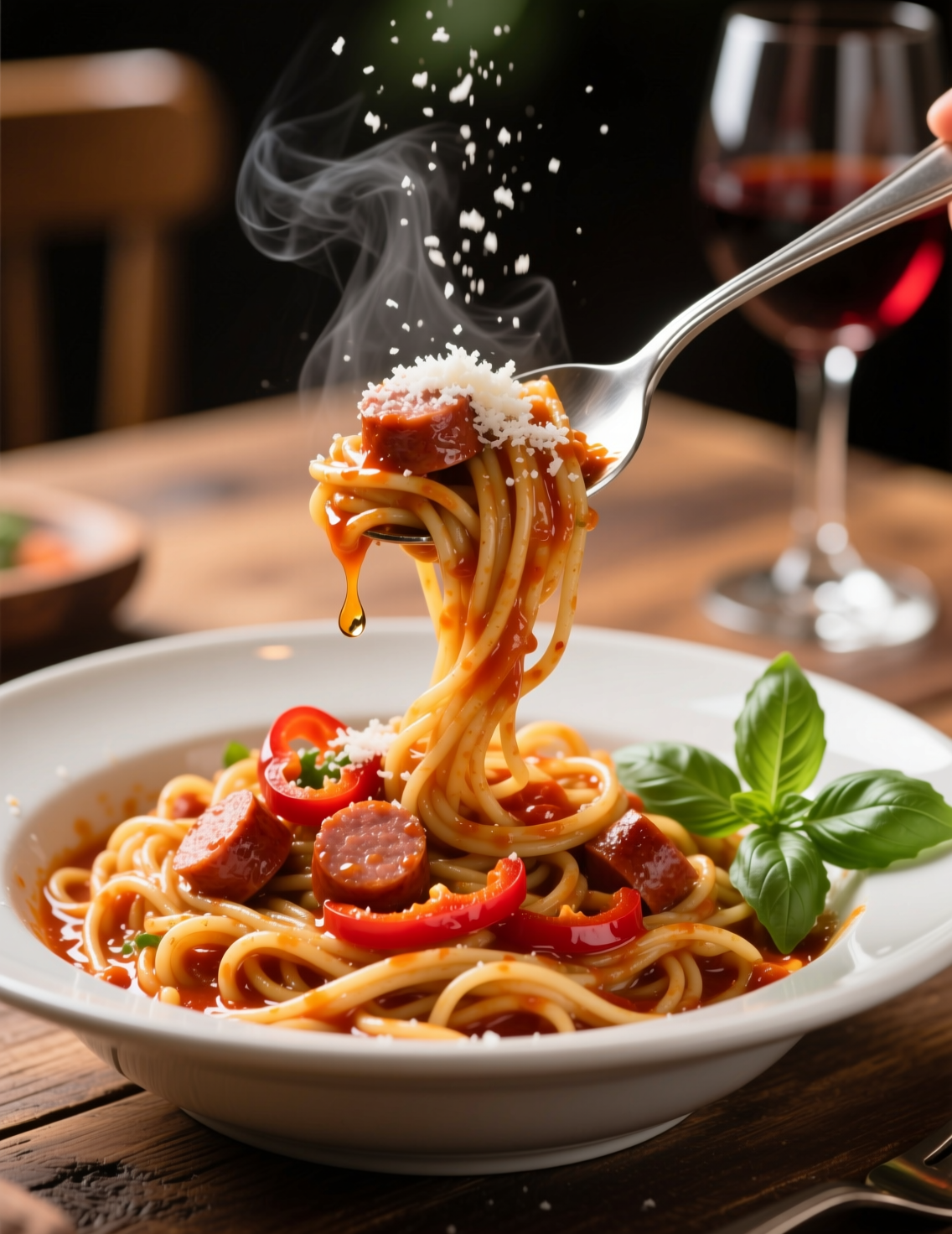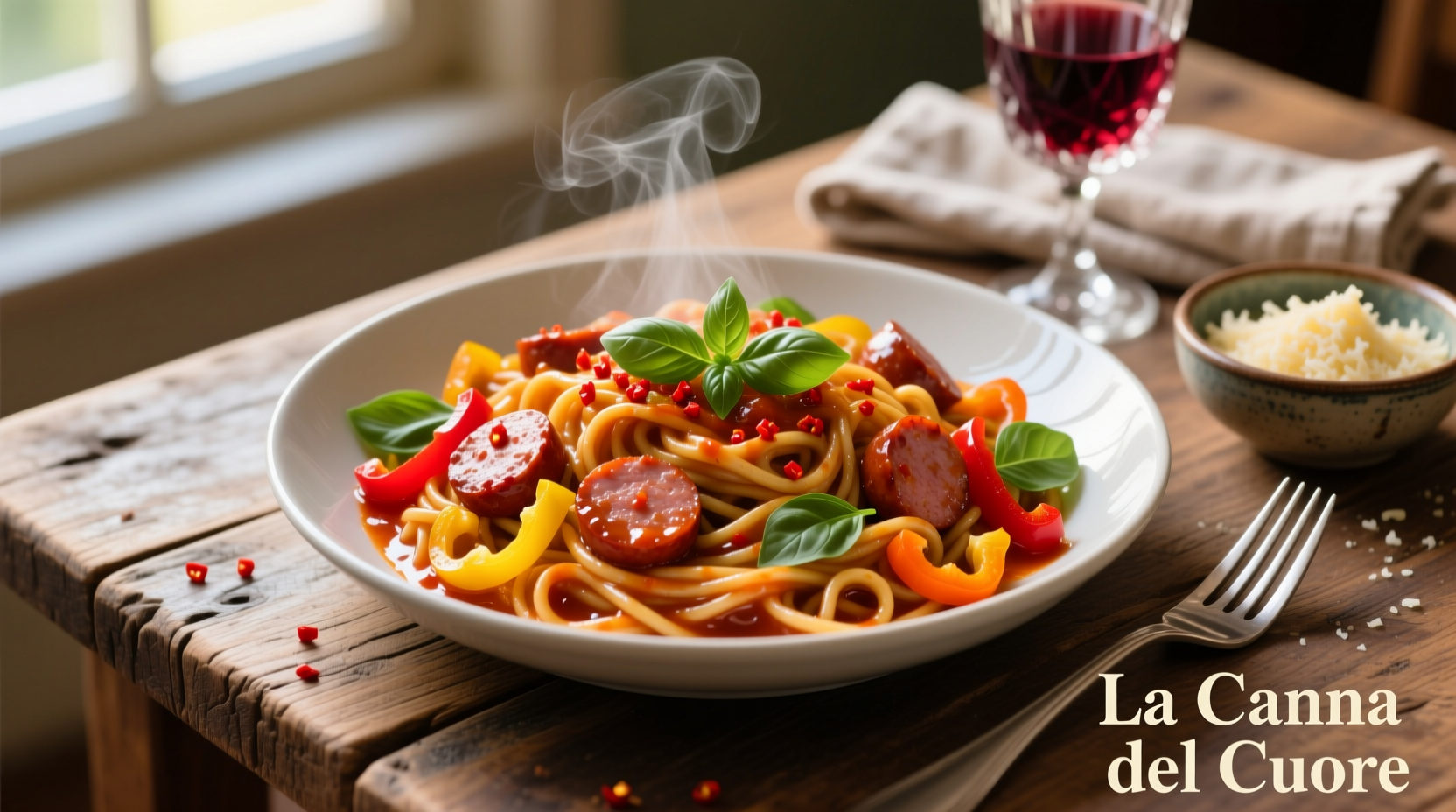There’s something bold about a dish that dares to borrow from two worlds—Italian warmth and Thai fire. Italian Drunken Noodles isn’t your average pasta plate. It’s a chaotic, glorious dance of spicy sausage, sweet bell peppers, and a garlicky tomato-wine sauce that clings to noodles like they were made for each other. And they kinda were.
If you’ve ever wondered what happens when Italy meets Thailand after a few glasses of wine—well, this recipe answers that with delicious certainty. Let’s get into it.
What Are Italian Drunken Noodles, Anyway?
Despite the name, these noodles aren’t a traditional Italian dish. Nope, not one Nonna in Rome is simmering this in her kitchen. The “drunken” part nods to the Thai dish Pad Kee Mao—or “Drunken Noodles”—which uses wide rice noodles and a spicy, savory sauce that often includes fish sauce, basil, and chili.
Italian Drunken Noodles take that fiery concept and give it a Mediterranean soul. Instead of rice noodles, we use tender Italian-style pasta—often pappardelle or fettuccine. Instead of Thai basil, we call in fresh sweet basil and oregano. Instead of fish sauce, it’s all about white wine and a deep tomato base.
A fusion done right feels familiar yet exciting. And this one nails it.
Ingredients Breakdown (for 6 servings)
To make this dish shine, ingredients must be fresh and bold. Quality matters here more than anywhere else.
- 1 pound Italian sausage (spicy or mild, depending on your mood)
- 12 ounces pappardelle or fettuccine pasta
- 2 tablespoons olive oil
- 1 large red onion, thinly sliced
- 1 red bell pepper, sliced
- 1 yellow bell pepper, sliced
- 4 cloves garlic, minced
- 1/2 teaspoon crushed red pepper flakes (optional, but honestly, don’t skip it)
- 1 cup cherry tomatoes, halved
- 1/2 cup dry white wine (Pinot Grigio or Sauvignon Blanc works beautifully)
- 1 (14.5 oz) can diced tomatoes
- 1 tablespoon tomato paste
- 1 teaspoon Italian seasoning
- 1/4 cup fresh basil, chopped
- Salt and black pepper to taste
- Freshly grated Parmesan, for serving
That’s your team. And like any good team, they each play a role—some subtle, some loud.

The Technique That Makes It Work
The beauty of this recipe lies in layering flavors, not rushing them. This isn’t dump-and-stir cooking. It’s more like conducting a small orchestra—every note matters.
Start by heating olive oil in a large skillet over medium-high heat. Toss in the sausage. Let it sizzle until browned and crisp around the edges, about 5 to 7 minutes. Remove the sausage but leave those precious drippings behind. They’re liquid gold.
In the same pan, add your sliced onions and peppers. Stir them occasionally, but let them get those caramelized bits. That’s flavor right there.
When they’re soft and glossy, stir in garlic and crushed red pepper flakes. That smell—yeah, it’s a whole mood.
Now pour in the white wine, scraping up the browned bits from the bottom. Let it simmer until reduced by half. Add your diced tomatoes, tomato paste, and Italian seasoning. Simmer again for about 10 minutes until it thickens slightly.
Bring back your sausage, stir, and reduce heat to low. Meanwhile, cook pasta in salted boiling water until just al dente. Toss the noodles straight into the skillet. Don’t rinse ‘em. That bit of starchy water helps the sauce hug every ribbon of pasta.
Finish with cherry tomatoes, fresh basil, and a generous handful of Parmesan. Taste it. Adjust salt. Maybe a crack of black pepper. Done.
Why White Wine?
You’d think red wine belongs in Italian cooking—and often, yeah, it does. But here, white wine adds brightness and a little acidity that balances the sausage fat and tomato sweetness. It’s the contrast that keeps this dish from feeling heavy.
If you skip it, you’ll notice something’s missing. The “drunken” charm, maybe.
Flavor Deep Dive: What’s Happening Here
This recipe works because it layers heat, acid, sweetness, and fat in perfect balance. The sausage brings salt and fat. The peppers and onions add natural sugar. Tomatoes and wine give acidity. Garlic and chili wake everything up.
That’s culinary harmony—each bite delivering a little drama but never chaos.
A quick chef’s trick? Don’t overcook your sauce. You want it saucy, not soupy. And don’t drown the pasta. Let the sauce coat it like silk.
Choosing the Right Pasta
Pappardelle wins for me—wide, eggy, and soft enough to hold that thick sauce. But fettuccine works too. Even tagliatelle if you’re feeling rustic. Avoid thin pasta like spaghetti—it won’t stand up to the bold sauce.
Fresh pasta gives a smoother texture, but dry pasta works fine if cooked properly. Just don’t overdo it.
Variations Worth Trying
Cooking’s all about play, right? So, tweak it.
- For a lighter version: use turkey or chicken sausage.
- For vegetarian: swap sausage for mushrooms, especially cremini or portobello. They bring that meaty chew.
- Want it creamier? A splash of heavy cream at the end turns it silky, like something straight out of a trattoria.
- Spice lover? Add more crushed red pepper or even a pinch of Calabrian chili paste.
Every variation tells a slightly different story, but all end deliciously.

Nutritional Insight
Let’s be real—it’s not a “diet” dish, but it’s balanced. One serving (roughly one-sixth of the recipe) gives around 500–550 calories, depending on the sausage and pasta used.
You get solid protein, complex carbs, and a fair dose of fiber and antioxidants from those peppers and tomatoes. Olive oil keeps your heart happy.
Pair it with a green salad, and you’ve got a meal that satisfies body and soul.
Common Mistakes (and How to Dodge Them)
- Overcooking the pasta: Classic rookie move. Pasta keeps cooking in the sauce, so stop early.
- Too much liquid: Wine and tomatoes release water; reduce it properly.
- Under-seasoning: Italian food depends on seasoning. Salt each layer. Don’t wait till the end.
- Skipping the deglaze: Those brown bits? That’s where the magic hides. Never skip scraping them up.
Wine Pairing Tips
Since you’re already using white wine in the sauce, stick with it on the table. Pinot Grigio, Sauvignon Blanc, or even a chilled rosé plays beautifully. If you prefer red, a light Chianti won’t overpower the spice.
The key is balance—nothing too oaky or too sweet.
The Origin Story: A Happy Accident
Italian Drunken Noodles came from creative chefs in America, playing around with Thai-Italian fusion. Some say it started in Florida, others in New York. Wherever it was born, it’s now a restaurant staple and a home-cooking favorite.
It’s proof that good food doesn’t always follow rules—it just follows flavor.
Pro Tips for Perfect Results
- Use fresh basil at the end, never early—it turns black if overcooked.
- A wide skillet works better than a pot. You want evaporation and caramelization.
- Don’t fear spice—it’s meant to bite a little. That’s the “drunken” kick.
- Always taste as you go. Recipes are guides, not laws.
Storage and Reheating
Leftovers? Lucky you. Store them in an airtight container in the fridge for up to 3 days.
When reheating, add a splash of water or broth to loosen the sauce. Reheat gently over medium heat—never blast it in the microwave unless you enjoy rubbery pasta.
It also freezes surprisingly well, though the texture softens slightly.
The Science Behind That Sizzle
When sausage browns, it goes through the Maillard reaction—proteins and sugars caramelize, creating hundreds of flavor compounds. That’s why you never skip the sear.
The wine’s alcohol evaporates but leaves behind esters and acids that amplify aroma and complexity. The tomato paste adds umami depth, acting as the backbone of the sauce.
This dish might feel rustic, but every step is grounded in solid culinary chemistry.
A Professional’s Perspective
I’ve made this recipe in restaurant kitchens and home stoves alike. The trick isn’t just in following instructions—it’s in the rhythm. Timing peppers just right. Letting wine simmer long enough to mellow. Tossing pasta at the perfect moment so it soaks up the sauce instead of swimming in it.
It’s food that feels alive, that asks you to slow down a bit and pay attention.
Serving Suggestions
Serve it hot, with shaved Parmesan snowing over the top and maybe a few basil leaves for color. A hunk of crusty bread on the side to mop the sauce? Always yes.
If you’re entertaining, serve in wide shallow bowls. This dish looks as good as it tastes—rustic but elegant.
Final Thoughts
Italian Drunken Noodles is the kind of dish that proves fusion can be more than a gimmick—it can be art. It’s spicy, saucy, and full of heart.
The secret lies in restraint—enough spice to tingle, enough acid to cut, and enough comfort to feel like home. Cook it slow, taste as you go, and serve it with love.
Because honestly, isn’t that the real magic of any great meal?
FAQs
What are Italian Drunken Noodles?
Italian Drunken Noodles are a fusion of Italian pasta and Thai-inspired spicy noodle flavors made with sausage, wine, and tomatoes.
Why are they called “Drunken” Noodles?
The term “drunken” comes from the splash of white wine in the sauce, inspired by Thailand’s Pad Kee Mao dish.
What type of pasta works best for this recipe?
Pappardelle or fettuccine are ideal since their wide ribbons hold the rich sauce perfectly.
Can I make Italian Drunken Noodles without sausage?
Yes, substitute mushrooms, chicken, or tofu for a delicious vegetarian or lighter version.
What wine should I use in the recipe?
A dry white wine like Pinot Grigio or Sauvignon Blanc enhances flavor without overpowering the dish.
Can I make this dish non-alcoholic?
Absolutely—replace the white wine with chicken or vegetable broth for a similar depth of flavor.
How spicy are Italian Drunken Noodles?
They have a mild-to-medium spice, but you can adjust by adding more or less crushed red pepper.
How do I store leftovers?
Store in an airtight container in the refrigerator for up to 3 days.
Can I freeze Italian Drunken Noodles?
Yes, they freeze well for up to 2 months, though the pasta may soften slightly when reheated.
What’s the best way to reheat leftovers?
Warm them gently on the stove with a splash of water or broth to loosen the sauce.
Can I use red wine instead of white?
You can, but it’ll make the sauce heavier and less bright in flavor.
How many servings does this recipe make?
The recipe serves 6 generous portions, perfect for family dinners or small gatherings.
Is this an authentic Italian dish?
No, it’s a modern Italian-American fusion inspired by Thai flavors.
What can I serve with Italian Drunken Noodles?
Pair with a green salad, garlic bread, or a crisp white wine for a complete meal.
How long does it take to make?
From start to finish, it usually takes around 40 minutes, including prep and cooking time.

Mariana is a passionate home cook who creates delicious, easy-to-follow recipes for busy people. From energizing breakfasts to satisfying dinners and indulgent desserts, her dishes are designed to fuel both your body and hustle.
When she’s not in the kitchen, she’s exploring new flavors and dreaming up her next recipe to share with the Foodie Hustle community.

